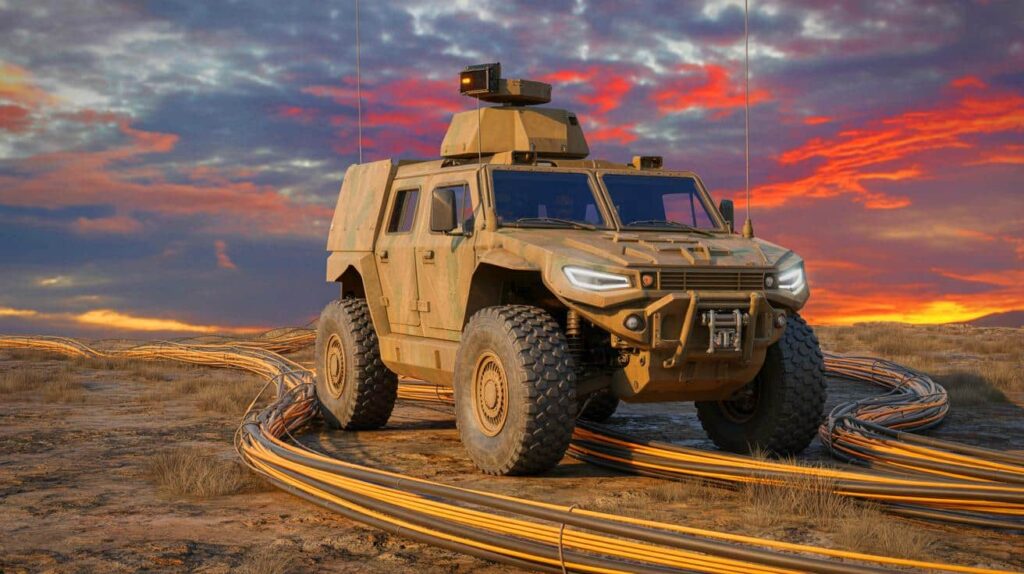
In a bold move to enhance battlefield capabilities while minimizing troop risks, Russian forces have converted Chinese-made all-terrain vehicles (ATVs) into remotely operated battlefield platforms. This transformation was executed by the 36th Guards Combined Arms Army of Vostok, converting Desertcross 1000-3 utility vehicles into autonomous systems. These modified vehicles can lay fiber-optic cables across hostile terrains, offering a strategic advantage in maintaining communications without endangering Russian signal troops. As the conflict in Ukraine continues, the adaptation of these vehicles demonstrates a shift in military strategy, emphasizing innovation and technology to reduce human exposure on the frontlines.
Remote Operations and Safety Concerns
Signal troops face significant risks when establishing communication lines in conflict zones. The introduction of modified ATVs aims to mitigate this danger by allowing the remote laying of fiber-optic cables. These vehicles are capable of laying up to five kilometers of cable over varied terrains, which is critical for maintaining secure network connectivity. By deploying these modified Desertcross platforms, the Russian military seeks to reduce the exposure of troops to enemy fire while ensuring logistical efficiency.
The ability to control these vehicles remotely not only minimizes human risk but also addresses logistical bottlenecks by maintaining communication lines in challenging environments. The conversion of these vehicles is a testament to the evolving nature of warfare, where technology and innovation play pivotal roles in enhancing operational capabilities while safeguarding human lives.
From Recreational Vehicles to Battlefields
The Desertcross 1000-3, originally built in China, was never intended for military use. Initially marketed as a recreational off-roader and commercial utility vehicle, it features a 72-horsepower gasoline engine, a 13-gallon fuel tank, and a cargo capacity of approximately 660 pounds. Despite its civilian origins, the vehicle’s affordability, availability, and adaptability have made it an attractive option for the Russian military.
Reports indicate that thousands of these vehicles were purchased by Russia in 2023. They are being utilized not only for logistical support but also in combat operations against Ukrainian positions. Some units have been equipped with weapons such as PKM machine guns, NSV or Kord heavy machine guns, and AGS-17 grenade launchers. Additionally, anti-drone measures like nets or cages have been added to protect against aerial threats, showcasing the vehicle’s versatility in various combat scenarios.
Improvised Innovation and Strategic Implications
The conversion of these ATVs into remote-controlled platforms involves the use of off-the-shelf electronics, supplemented by 3D-printed components. This approach underscores Russia’s reliance on improvised innovation to address battlefield challenges. Operators can manage these vehicles from a safe distance, effectively treating them as disposable assets in high-risk zones.
This strategy allows for diverse applications, including communication, supply runs, and combat operations, ultimately aiming to preserve soldier lives while addressing the realities of heavy losses on the battlefield. The ingenuity behind these conversions highlights Russia’s ability to adapt civilian technology for military purposes, illustrating the dynamic nature of modern warfare.
The adaptation of the Desertcross vehicles represents both a strategic advantage and a vulnerability for Russia. While these vehicles reduce troop exposure and provide flexible support for frontline operations, they remain lightly built, unarmored, and susceptible to destruction by Ukrainian forces. This initiative highlights the blurred lines between civilian technology and military hardware as armies seek cost-effective solutions amid industrial strain and battlefield demands.
As the conflict in Ukraine progresses, the strategic implications of these conversions become increasingly significant. The ability to leverage civilian technology for military use reflects broader trends in modern warfare, where innovation and adaptability are key factors in maintaining operational superiority.
The use of modified ATVs in the Ukrainian conflict signifies a shift in military tactics, emphasizing the importance of technology and innovation in modern warfare. As global conflicts continue to evolve, the question remains: how will military forces worldwide continue to adapt civilian technologies for battlefield success?






